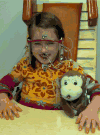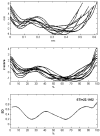Semantic richness and word learning in children with autism spectrum disorder
- PMID: 28470820
- PMCID: PMC5671375
- DOI: 10.1111/desc.12543
Semantic richness and word learning in children with autism spectrum disorder
Abstract
Semantically rich learning contexts facilitate semantic, phonological, and articulatory aspects of word learning in children with typical development (TD). However, because children with autism spectrum disorder (ASD) show differences at each of these processing levels, it is unclear whether they will benefit from semantic cues in the same manner as their typical peers. The goal of this study was to track how the inclusion of rich, sparse, or no semantic cues influences semantic, phonological, and articulatory aspects of word learning in children with ASD and TD over time. Twenty-four school-aged children (12 in each group), matched on expressive vocabulary, participated in an extended word learning paradigm. Performance on five measures of learning (referent identification, confrontation naming, defining, phonetic accuracy, and speech motor stability) were tracked across three sessions approximately one week apart to assess the influence of semantic richness on extended learning. Results indicate that children with ASD benefit from semantically rich learning contexts similarly to their peers with TD; however, one key difference between the two groups emerged - the children with ASD showed heightened shifts in speech motor stability. These findings offer insights into common learning mechanisms in children with ASD and TD, as well as pointing to a potentially distinct speech motor learning trajectory in children with ASD, providing a window into the emergence of stereotypic vocalizations in these children.
© 2017 John Wiley & Sons Ltd.
Figures







Similar articles
-
Visual and verbal semantic productions in children with ASD, DLD, and typical language.J Commun Disord. 2019 Nov-Dec;82:105921. doi: 10.1016/j.jcomdis.2019.105921. Epub 2019 Jul 20. J Commun Disord. 2019. PMID: 31351344 Free PMC article.
-
Word learning by preschoolers with specific language impairment: effect of phonological or semantic cues.J Speech Lang Hear Res. 2005 Dec;48(6):1452-67. doi: 10.1044/1092-4388(2005/101). J Speech Lang Hear Res. 2005. PMID: 16478383
-
Online comprehension across different semantic categories in preschool children with autism spectrum disorder.PLoS One. 2019 Feb 11;14(2):e0211802. doi: 10.1371/journal.pone.0211802. eCollection 2019. PLoS One. 2019. PMID: 30742652 Free PMC article. Clinical Trial.
-
Communication interventions for autism spectrum disorder in minimally verbal children.Cochrane Database Syst Rev. 2018 Nov 5;11(11):CD012324. doi: 10.1002/14651858.CD012324.pub2. Cochrane Database Syst Rev. 2018. PMID: 30395694 Free PMC article.
-
Auditory-visual misalignment: A theoretical perspective on vocabulary delays in children with ASD.Autism Res. 2018 Dec;11(12):1621-1628. doi: 10.1002/aur.2038. Epub 2018 Nov 26. Autism Res. 2018. PMID: 30475450 Free PMC article. Review.
Cited by
-
Word imageability is associated with expressive vocabulary in children with autism spectrum disorder.Autism Dev Lang Impair. 2022 Mar 16;7:23969415221085827. doi: 10.1177/23969415221085827. eCollection 2022 Jan-Dec. Autism Dev Lang Impair. 2022. PMID: 36382067 Free PMC article.
-
An Application of Network Science to Phonological Sequence Learning in Children With Developmental Language Disorder.J Speech Lang Hear Res. 2018 Sep 19;61(9):2275-2291. doi: 10.1044/2018_JSLHR-L-18-0036. J Speech Lang Hear Res. 2018. PMID: 30167667 Free PMC article.
-
The influence of evaluative right/wrong feedback on phonological and semantic processes in word learning.R Soc Open Sci. 2018 Sep 5;5(9):171496. doi: 10.1098/rsos.171496. eCollection 2018 Sep. R Soc Open Sci. 2018. PMID: 30839710 Free PMC article.
-
A longitudinal study of the phonological organisation of novel word forms in children with developmental language disorder.Int J Speech Lang Pathol. 2022 Apr;24(2):212-223. doi: 10.1080/17549507.2021.1975816. Epub 2021 Sep 26. Int J Speech Lang Pathol. 2022. PMID: 34565237 Free PMC article.
-
Atypical structural connectivity of language networks in autism spectrum disorder: A meta-analysis of diffusion tensor imaging studies.Autism Res. 2022 Sep;15(9):1585-1602. doi: 10.1002/aur.2789. Epub 2022 Aug 13. Autism Res. 2022. PMID: 35962721 Free PMC article. Review.
References
-
- American Psychiatric Association. Diagnostic and statistical manual of mental disorders: DSM-5. 5th. Washington, D.C: American Psychiatric Association; 2013.
-
- Angwin AJ, Phua B, Copland DA. Using semantics to enhance new word learning: An ERP investigation. Neuropsychologia. 2014;59(0):169–178. http://dx.doi.org/10.1016/j.neuropsychologia.2014.05.002. - DOI - PubMed
-
- Baron-Cohen S, Baldwin DA, Crowson M. Do children with autism use the speaker’s direction of gaze strategy to crack the code of language? Child Development. 1997;68(1):48–57. - PubMed
Publication types
MeSH terms
Grants and funding
LinkOut - more resources
Full Text Sources
Other Literature Sources
Medical

